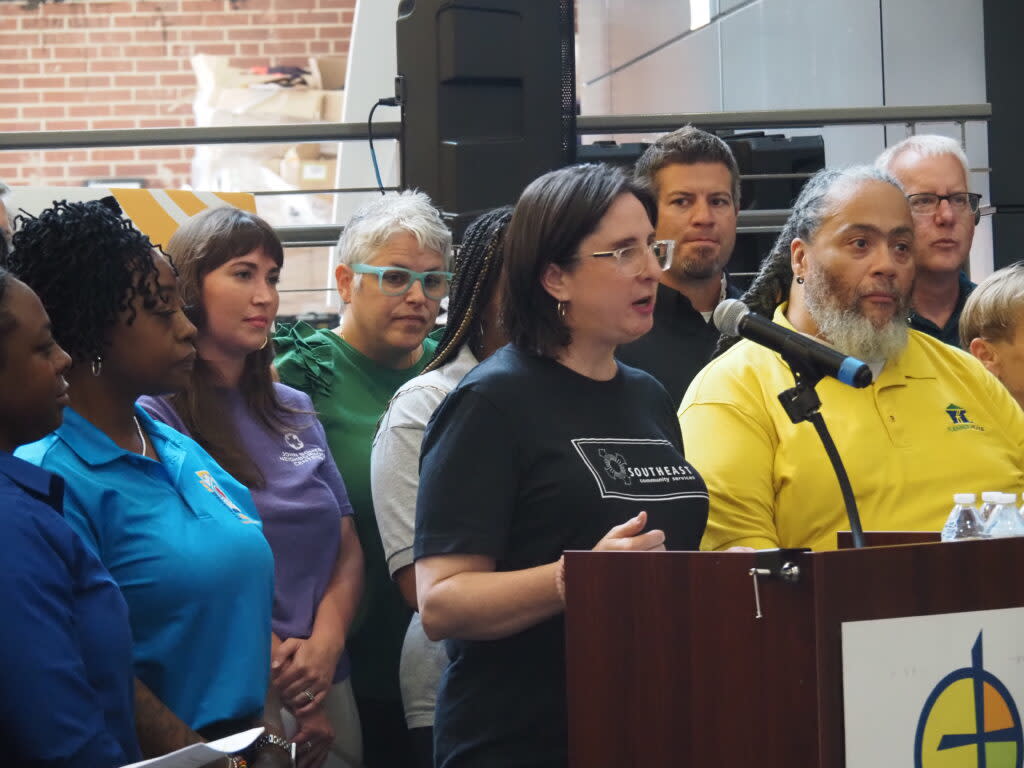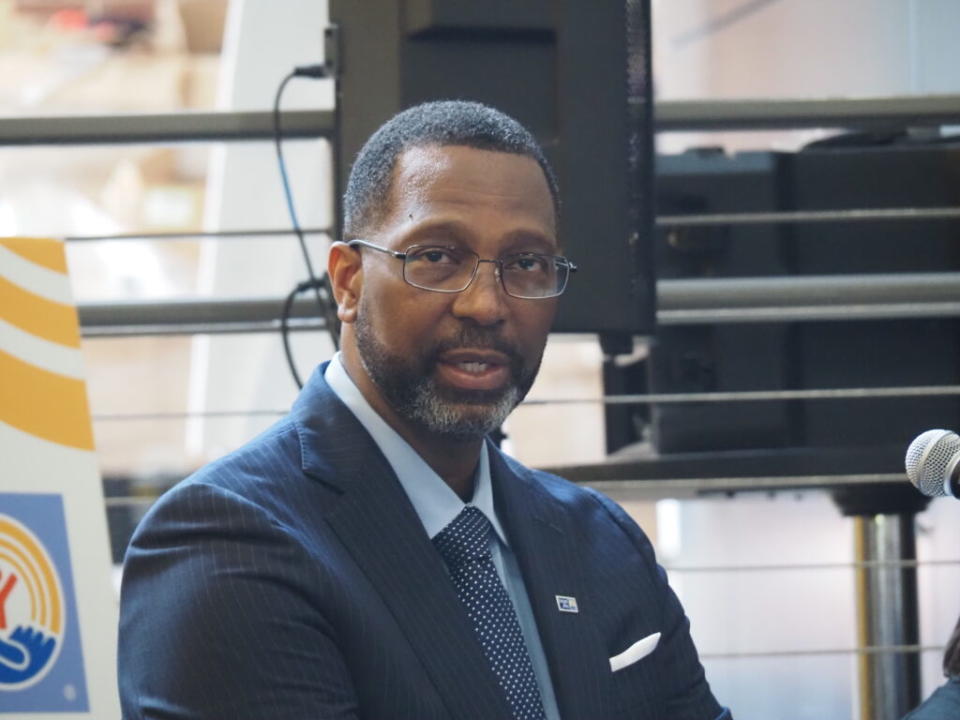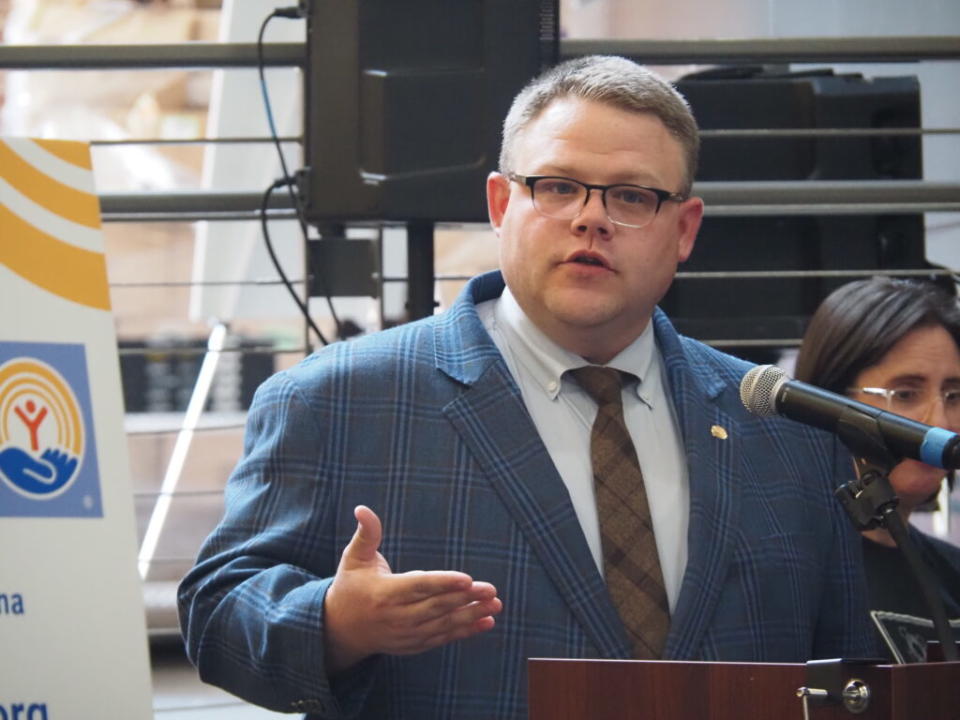Central Indiana nonprofits relieve medical debt of more than 100,000 residents

Southeast Community Services Executive Director Peggy Frame speaks on behalf of the United Neighborhood Centers of Indianapolis during a medical debt relief event on Monday, June 17, 2024. (Leslie Bonilla Muñiz/Indiana Capital Chronicle)
More than 100,000 people throughout central Indiana are now free of medical debt.
“You no longer have to pay this debt to anyone,” say letters mailed out this weekend.
The United Neighborhood Centers of Indianapolis and United Way of Central Indiana jointly donated $1.7 million to eliminate nearly $240 million in medical debt for 112,018 impoverished or heavily indebted people living in Boone, Hamilton, Hancock, Hendricks, Marion, Morgan and Putnam counties. About 90% live in Indianapolis.
Debt relief by the numbers
Boone County: $437,300 relieved for 262 people
Hamilton County: $1.2 million relieved for 737 people
Hancock County: $466,600 relieved for 313 people
Hendricks County: $2.2 million relieved for 1,286 people
Marion County: $234.2 million relieved for 108,699 people
Morgan County: $710,200 relieved for 496 people
Putnam County: $272,100 relieved for 225 people
The groups partnered with Undue Medical Debt, an organization that bulk-buys medical debt at a discount, then wipes it out. The debt relief campaign will benefit those at or below 400% of the federal poverty level — which is $125,000 for a family of four — and those with debt at 5% or more of their annual income.
“For countless neighbors, a visit to the doctor or a hospital stay can result in debt that can haunt them for years,” said Peggy Frame, executive director of Southeast Community Services. She spoke on behalf of the 13-member United Neighborhood Centers of Indianapolis.
“It is time for us to acknowledge that health care is a fundamental human right, not a privilege reserved for the wealthy,” Frame continued. “We must strive for a system that ensures affordable access to quality care without the fear of financial ruin.”
One in five Marion County residents — and about 16% of Hoosiers overall — had medical debt in collections in 2022, according to an Urban Institute database. Indiana is eleventh in the country for the high share of its population with medical debt in collections, per a 2022 report by the federal Consumer Financial Protection Bureau.
Almost two-thirds of Americans who’ve declared bankruptcy said medical expenses contributed, in a 2019 study.
Frame said the initiative began focused on Marion County but expanded beyond it when the United Way of Central Indiana joined the effort.
United Way of Central Indiana President and CEO Fred Payne said his organization hoped to do more than make a “crisis intervention.”

“At United Way, we’re fighting for the long-term health and economic well-being of every person in our community,” Payne said.
The United Way of Central Indiana’s share of the donation — $500,000 — was part of a gift made by philanthropist MacKenzie Scott, the ex-wife of Amazon billionaire Jeff Bezos. The United Neighborhood Centers of Indianapolis’ share, $1.2 million, came from an anonymous donor.
The donor spoke directly to state lawmakers in a letter read by Sean Huddleston, president of Martin University: “The bigger story is the massive problem medical debt creates in our country, state and neighborhoods. We would encourage our state legislators and our medical delivery entities to make policy changes in four areas.”
Those four areas include:
Charity care and financial assistance: Increase the income threshold to qualify, screen patients for eligibility before billing and notify patients of discount options at each payment point in case their income has changed.
Credit scores: Prevent medical debt from being reported against patients’ credit score — outright, or up to a certain balance — and avoid wage garnishment to collect unpaid debt.
Collections: Require debt collectors to inform patients when their debt has passed statutory repayment terms.
Cost of care: Require providers to delay a medical debt’s referral to collections while the patient appeals billing, establish price transparency and standardization, encourage hospitals to enroll uninsured patients in Affordable Care Act plans, Medicaid or other resources so future care may be covered.
Advocates have pushed for medical debt help before.
Huddleston said some health care systems had already made changes, noting that the state’s four largest have raised income thresholds for charity care, and have links on their websites to find price estimates.

Several systems have also abolished wage garnishment for medical debt, he added.
Samuel Snideman, United Way of Central Indiana’s vice president for government affairs, called the donor’s policy recommendations “initial steps.”
“Hundreds of thousands of people and their families will benefit from debt relief now and our communities will be better for it. While a one time investment will have a ripple effect … it doesn’t address the root causes of medical debt or financial hardship,” he said.
Snideman told reporters that while letters to indebted Hoosiers were mailed out over the weekend, the money transfers have already been made.
GET THE MORNING HEADLINES DELIVERED TO YOUR INBOX
The post Central Indiana nonprofits relieve medical debt of more than 100,000 residents appeared first on Indiana Capital Chronicle.

